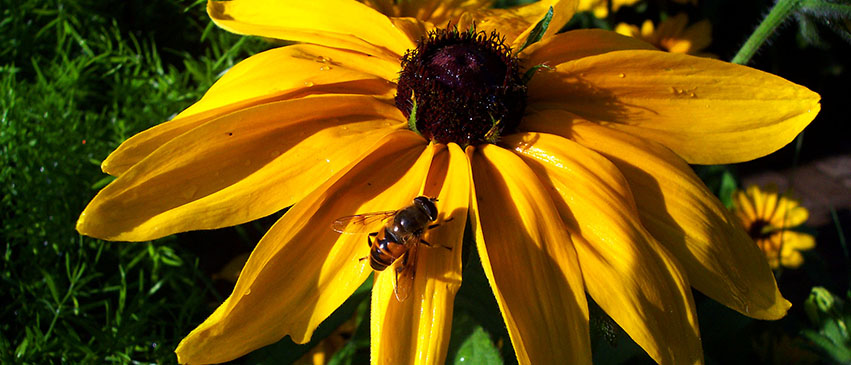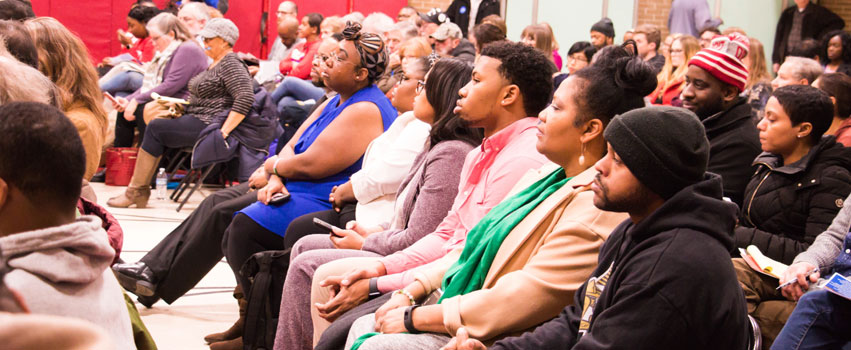Designing for Pollinators

In the tranquil calm of sunny afternoon, butterflies flutter between plants and bees race from flower to flower, all focused on gathering pollen or nectar… and making nature work. A pollinator is any creature that moves pollen between plants or within flowers, leading to fertilization and potentially fruit/seed formation. We generally think of the iconic honeybee when we think of pollinators, but there are 300 to 400 bee species in Illinois, and many of them are pollinators. The honeybee does much of the work, but depending on the plants involved, native bees, butterflies, moths, wasps, hummingbirds, beetles and even flies act as pollinators.
Pollinators should matter to all of us because we greatly depend on them for the food we eat. One out of every three bites are dependent upon pollinators. If you were to include indirect products—like the milk and beef from alfalfa-fed cattle—it would be even higher. Without pollinators, many food crops would be lost and our ecosystems would collapse, because pollination is essential for seed formation and plant survival.
Fortunately, there are many changes you can make that will benefit pollinators. Whether you have an expansive acreage or a small patio, you can easily incorporate them into your garden.
Planting a Diverse Palette
When planting for pollinators, the palette should be diverse and include native plants. Everybody likes a buffet! By using a variety of plants, you can provide for a diversity of pollinators. If possible, make it obvious or easy to find by planting in clumps or masses, rather than single, scattered plants. It is especially important to plant native plants (i.e. aster, currant, dogwood, elderberry, false aster, goldenrod, milkweed, oak, serviceberry, sumac or willow), because native pollinators have evolved with these plants, and they often form deep genetic relationships.
In addition, there are many common plants that benefit pollinators, including alyssum, allium, boxwood, catmint, chives, cosmos, crocus, lilac, marigolds, mint, oregano, phlox, salvia, sedum, spiraea, sunflowers, yarrow, rosemary, Russian sage, verbena and zinnia. Try to avoid fancy, double flowers; these “perfect” blooms are often sterile and offer limited benefits to pollinators.
What to Provide
First, you’ll want to provide water using a shallow puddle or stone with a shallow depression to collect water. Place it under a downspout, birdbath or faucet to provide a consistent water source.
You will also want to provide shelter and nesting sites using densely layered vegetation, evergreens, big mature trees, thickets, brush piles or groupings of food/nectar plants. Great nesting sites include perennials and grasses left to over-winter, dead wood, rotting logs, leaves, wood piles and nesting boxes. Even open, undisturbed soil can be beneficial to ground-nesting pollinators. Refrain from cutting everything back in the fall, as butterflies and bees often overwinter in the plant stems.
What to Minimize
Most importantly, work to minimize or eliminate pesticides. Many pesticides are especially harmful to bees because a bee visits hundreds of flowers, increasing the potential for pesticide exposure. Never use one of the neonicotinoid pesticides, because they have proven to be problematic for bees. Avoid pesticides by using alternative pest control options like pruning, hand removal or water sprays—or use the least toxic option and spray in the early morning, when pollinators are less active. Lastly, with any pesticide, it is imperative to read the label thoroughly before purchasing and apply as directed.
Minimize your lawn as well, using only what you need. A mowed lawn provides few benefits for wildlife and pollinators, while a treated lawn poses a hazard. Take a more nature-friendly approach to lawn care by mowing grass to 21/2 inches, leaving clippings, applying organic fertilizers, eliminating pesticides and embracing clover in your lawn.
Connecting With the Wild
Native ecosystems like meadows, wetlands and forests provide incredible benefits for pollinators. Look beyond your garden and provide connections between wild or natural areas by creating corridors/rest areas of planting that provide pollinators with shelter and food. Efforts are being taken by many government agencies to develop pollinator strips along highways, for example. By mowing less or changing the plant palette, these changes have had a huge impact.
Feed Your Curiosity
Get a butterfly or bee guidebook and learn to recognize pollinators… or perhaps inventory and study the pollinators in your garden. The following organizations are great resources if you want to learn more about pollinators:
- National Wildlife Federation (Get your garden certified as a wildlife habitat!): nwf.org
- The Xerces Society: xerces.org
- Illinois Natural History Survey: www.inhs.uiuc.edu
- U.S. Forest Service: www.fs.fed.us/wildflowers/pollinators
- Pollinator Partnership: pollinator.org
As gardeners, we can easily do our part by creating pollinator-friendly gardens and protecting habitat, but the greater joy comes from sharing your garden with bees, butterflies and good friends. PM
Bob Streitmatter is manager at Luthy Botanical Garden, a Peoria Park District facility located at 2520 North Prospect Road, just north of the Peoria Zoo.
